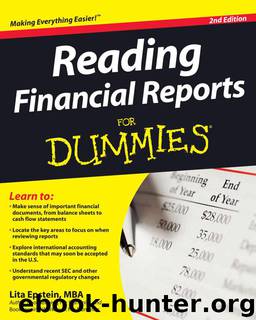Reading Financial Reports for Dummies by Lita Epstein

Author:Lita Epstein [Epstein, Lita]
Language: eng
Format: epub
ISBN: 9781118761939
Amazon: 1118761936
Publisher: For Dummies
Published: 2013-12-31T05:00:00+00:00
The key question to ask is whether a company’s current ratio shows that it’s able to cover short-term obligations. Generally, the rule of thumb is that any current ratio between 1.2 and 2.0 is sufficient for a business to operate. Keep in mind that the ratio varies among industries.
A current ratio below 1 is a strong danger sign that the company is headed for trouble. A ratio below 1 means the company is operating with negative working capital; in other words, its current debt obligations exceed the amount of money it has available to pay those debts.
A company also can have a current ratio that’s too high. Any ratio over 2
means the firm isn’t investing its assets well. The company can probably put some of those short-term assets to better use by investing them in growth opportunities.
However, many lenders and analysts believe that the current ratio isn’t a good enough test of a company’s debt-paying ability because it includes some assets that aren’t easy to turn into cash, such as inventory. A company must sell the inventory and collect the money before it has cash to work with, and doing so can take a lot more time than using cash that’s already on hand, or just collecting money due for accounts receivable, which represent customer accounts for items already purchased.
Determining the Quick Ratio
Stricter than the current ratio is a test called the quick ratio or acid test ratio, which measures a company’s ability to pay its bills without taking inventory into consideration. The calculation includes only cash on hand or cash already due from accounts receivable. Unlike the current ratio, the quick ratio doesn’t include money anticipated from the sale of inventory and the collection of money from those sales. To calculate this ratio, you use a two-step process: First, find the assets that a company can quickly turn into cash; then divide those quick assets by the current liabilities.
Calculating the quick ratio
Here’s the two-step process you use to find the quick ratio: 174 Part III: Analyzing the Numbers
Download
This site does not store any files on its server. We only index and link to content provided by other sites. Please contact the content providers to delete copyright contents if any and email us, we'll remove relevant links or contents immediately.
The Black Swan by Nassim Nicholas Taleb(7055)
Bad Blood by John Carreyrou(6581)
Pioneering Portfolio Management by David F. Swensen(6253)
Millionaire: The Philanderer, Gambler, and Duelist Who Invented Modern Finance by Janet Gleeson(4420)
Skin in the Game by Nassim Nicholas Taleb(4201)
Bullshit Jobs by David Graeber(4138)
The Money Culture by Michael Lewis(4132)
Skin in the Game: Hidden Asymmetries in Daily Life by Nassim Nicholas Taleb(3960)
The Wisdom of Finance by Mihir Desai(3693)
Blockchain Basics by Daniel Drescher(3540)
Liar's Poker by Michael Lewis(3413)
Fooled by Randomness: The Hidden Role of Chance in Life and in the Markets by Nassim Nicholas Taleb(3080)
Hands-On Machine Learning for Algorithmic Trading by Stefan Jansen(3042)
The Intelligent Investor by Benjamin Graham Jason Zweig(3010)
Mastering Bitcoin: Programming the Open Blockchain by Andreas M. Antonopoulos(3010)
The Power of Broke by Daymond John(2932)
Investing For Dummies by Eric Tyson(2920)
Market Wizards by Jack D. Schwager(2669)
Zero Hour by Harry S. Dent Jr. & Andrew Pancholi(2628)
